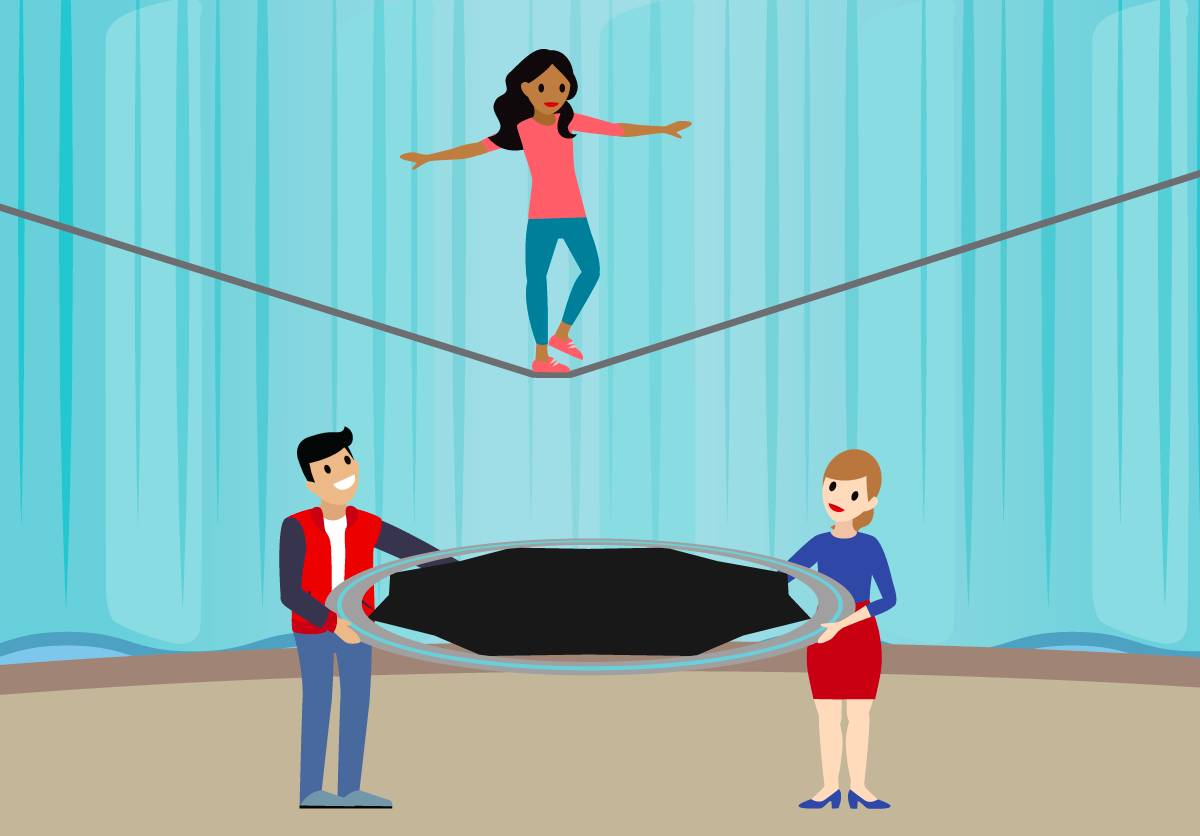Explore Psychological Safety
Learning Objectives
After completing this unit, you’ll be able to:
- Summarize why establishing a psychologically safe working environment is important.
- Explain how interpersonal risk influences our ability to speak up at work.
- Describe how speaking up and taking smart risks benefit business health and workplace culture.
Salesforce’s Fearless Journey
Today, we’re living in a world that’s changing at a breakneck pace. Our work is becoming increasingly complex and volatile, and our workplaces more dynamic, diverse, and dispersed. To get up to speed on new people, projects, products, and deadlines—and to deliver quality work—we can’t go it alone, hang back, or stay silent. Instead, we must create high-performing teams that communicate clearly and collaborate effectively—and that reflect the core value of Trust that’s so integral to our culture at Salesforce.
At Salesforce, we’ve embarked on a journey to create fearless, high-performing teams. This includes providing the space, safety, and skills for employees to freely contribute observations, offer ideas, ask questions, and voice concerns. In this environment of psychological safety, we’re building a culture of courage in which our employees can approach leaders and coworkers with what they see, what they know (and don’t know), and what they’d like to do.
As a result, our employees provide crucial information about our work—and themselves—that supports innovation. We’re excited about our journey and to offer you some insights and tools for you to start fostering psychological safety and build high-performing teams at your organization.
“Wait… back up. Psychological safety? Is that a seat belt for my brain?” Not quite. The term psychological safety was identified as a key workplace factor by Amy Edmondson, Novartis Professor of Leadership at Harvard Business School and author of The Fearless Organization. Psychological safety is about creating a climate in which employees are able to “speak up, express their concerns, and be heard… where people are not full of fear, and not trying to cover their tracks to avoid being embarrassed or punished.”
We’ve had the great fortune of having Amy serve as an executive advisor to Salesforce to help guide us in creating this learning journey. With her help, we’re establishing a more psychologically safe environment—one that empowers us to be vulnerable and authentic so that we can deeply connect with our coworkers. We’re not all the way there yet, but we’re excited to share what we’ve learned so that you can create fearless, high-performing teams as well.
The Risky Business of Speaking Up
You might be thinking, “Psychological safety and fearless teaming sound solid, but I’m not sure I’m ready to share. I’m worried about speaking up and potentially looking stupid.”
We get it: Slipping into silence is much more comfortable than getting side eye from our team. We’re genetically programmed to maintain the status quo, and we naturally respond to most threats by shutting up and shutting down our strategic thinking. That’s why we, as employees, might be inclined to keep our heads down when we see a project headed for disaster, refuse to ask for help even when we suspect others want and need it too, and clam up even when we catch errors or see potential improvements.

And, if we’re being totally honest, speaking up can be scary. This is especially true if we’re speaking up in a space where we worry that there might be repercussions for asking questions, sharing a different point of view, or challenging an established belief. Unless we’re confident that our comment will be well received, most of us will likely hold back. Here are a few situations that might look familiar.
- Your manager proposes adding a new step to a process, and you immediately sense that it will cause major problems downstream. You stay silent because you’re afraid of facing repercussions for speaking up—after all, you might be wrong.
- One of your teammates catches a mistake that would’ve cost the company money. Instead of praising the employee for pointing it out, the product manager reprimands the entire team for failing to catch the error earlier.
- An employee working remotely offers an insight that isn’t in line with those that have already been shared. The idea is innovative, but because it’s coming from outside of the office, and no one else appears to agree with it, it’s dismissed.
In situations such as these, where we don’t feel psychologically safe, we attempt to figure out whether certain behaviors might be “interpersonal risks,” or ones that open us up to ridicule, rejection, or even punishment. Here are a few examples of behaviors that might be considered interpersonal risks.
| We don’t… |
At the risk of being seen as... |
|---|---|
| Ask questions |
Ignorant |
| Admit mistakes |
Incompetent |
| Suggest ideas |
Out of line |
| Raise concerns |
Negative |
| Challenge the status quo |
Disruptive |
If we have any inkling that a behavior is “risky” and might negatively affect our self-image, status, or career, we might naturally try to manage the timing or context carefully or avoid the behavior altogether. We don’t want to be the one “rocking the boat,” “killing the vibe,” or “not getting it.” This isn’t just bad for business—it also takes a toll on us as individuals. When we don’t speak up, we’re not being heard, and this can result in feelings of exclusion, isolation, anxiety, and regret.
In many cases, though, taking these interpersonal risks as employees is what we should do—no, must do—to fearlessly contribute our personal best, push our team toward high performance, and move the business forward.
Reaping the Rewards of Risk
You’re probably familiar with the phrase, “The squeaky wheel gets the grease.” Well, that grease is good stuff! When we squeak—um, we mean speak—up, we:
- Gain access to ideas and expertise from diverse perspectives
- Improve coordination among geographically spread-out teams
- Increase employee well-being, self-confidence, and engagement
- Create a more inclusive environment
- Strengthen company culture

All of these things help build strong, successful teams that work fearlessly together. That’s because, in a psychologically safe environment, being courageous, speaking up, and challenging the status quo are not seen as personal risks, but rather as opportunities for learning and innovation. We’re all willing to put ourselves out there because we’re certain that our team and manager—even though they might not agree with us 100 percent of the time—understand the value of our risk taking, even if we fail.

“Ah! It’s about trust, then!” Well, to be clear: Psychological safety and trust are not the same thing. Trust is established between individuals. It’s built and eroded by small (not grand) gestures that accumulate over time. Psychological safety is established at the team level. But many of the behaviors that build interpersonal trust also build psychological safety and trust within a team.
For example, when interacting with another person, there are lots of little things that you do to build trust, such as:
- Paying attention
- Keeping your word
- Saying thank you
- Apologizing for mistakes
You can carry these behaviors into your team settings to help build psychological safety. However, in a team setting, you should focus not only on gaining interpersonal trust but also on improving the climate for the entire team by:
- Remaining curious about diverse perspectives
- Keeping confidential information private
- Acknowledging smart risks
- Being honest and upfront
- Holding yourself and others accountable
“Wait a minute. Now you’re just talking about being nice.” Well, being nice doesn’t hurt. But trust and psychological safety aren’t merely about being polite and making others feel comfortable. In fact, often what we believe to be “nice” is actually holding back the truth from someone—and that may be natural, but it isn’t particularly caring. Psychological safety is more about setting clear expectations and being candid and open, even if telling the truth is difficult or uncomfortable. This doesn’t mean that “anything goes” and that we can say and do whatever we want. It does mean establishing a climate in which we can exchange ideas, share different points of view—and even engage in a little productive conflict—all while supporting one another in a respectful way.
When we feel safe to speak up, and have trust in the members of our team, we’re in a great position for high performance. In the next unit, we learn all about the relationship between psychological safety and building fearless, high-performing teams. So, fasten your brain belt (or whatever), and get ready to get fearless!